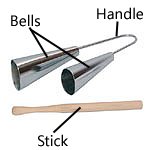|
Capoeira Instruments - AgogoThe little agogo makes a big sound compared to other capoeira instruments, even in a capoeira roda. I learn this the hard way every time I mess up with it in the roda… Everyone hears it! Even with its simplicity, this Brazilian cowbell has a lot of variation from design to use. Types of Bells
There’s a lot of variations on these simple bells. The first major difference is the material it’s made of. They can be made from wood, nuts or metal…
These capoeira instruments also differ in the number of bells they have. They range anywhere from one, to the four bells used in samba groups. In fact they’re used in a lot of ways… Usage
Within capoeira, the agogos are used to compliment the rhythm of the roda. They usually follow a pattern similar to the pandeiro or atabaque. The difference is that they have a much higher tone and stand out a lot more in the music of capoeira. You can hear their clear ring above the other capoeira instruments in the roda. In addition to capoeira, these hand bells are used a lot in Brazilian samba music. It’s believed that they may possibly be the oldest samba instrument as they derived from the similar African Yorba bells. The bells used in samba have up to 4 per instrument, compared to the 2 in capoeira. Enough talking about where it’s used, now learn what it is! Parts of Agogo
This is one of the simplest of the capoeira instruments having a few key parts. 
These simple parts come together to make a cool little instrument. The next step is figuring out where to start. Luckily it’s as easy as waving a wand… How to Play
The basics of this instrument are really straight forward. You just hit the bells with a stick! However it’s the play of the different tones of the bell that create rhythms useful in capoeira. Of the two bells, one will make a lower tone than the other. To explain some rhythms I’ll differentiate the tones by L for low and H for high. R will stand for rest. Here are some basic rhythms used in the capoeira roda:
Where to Buy
Virtual Capoeira sells a straight forward metal agogo. Check it out here! Return from Agogo to Capoeira Instruments
|


